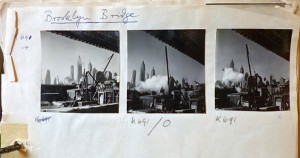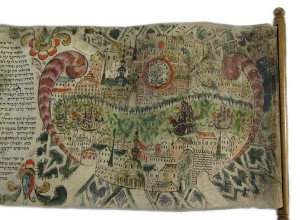My Week of Intensive Research into Fred Stein’s Archives

Contact sheet Brooklyn Bridge
© Estate of Fred Stein, photo: Theresia Ziehe
In June of 2012 I had the opportunity to delve into the estate of Fred Stein. During the preparation for our then-upcoming exhibition “In an Instant,” I travelled to the little town of Stanfordville, NY to visit Peter Stein, the photographer’s son and archive administrator. For a week, I studied the voluminous and multi-faceted material stored in various rooms of the private residence. It was an unforgettable immersion into the life and work of Fred Stein.
Hundreds of negatives, kept in fireproof cabinets, make up the core of the collection. Their differing formats point to the two cameras Stein photographed with: coiled strips of Leica negatives and individually packaged 2 1/4 x 2 1/4 inches negatives in pergamin sheets from the Rolleiflex. The cameras themselves unfortunately didn’t survive. Among these negatives, you can see Stein’s first shots of Dresden shortly before he emigrated to Paris in 1933. → continue reading

Detail of a Megillah, Germany, 18th century
© Jewish Museum Berlin. Photo: Michaela Roßberg
Today, 16 March, Jewish communities are celebrating Purim. On this holiday, the biblical Book of Esther is read aloud in synagogue. In keeping with tradition, the story of Esther—who saves the Jewish people in the Persian Empire from destruction by Haman, the king’s highest-ranking official—is read not from a book but from a parchment scroll. Commenting on the (Hebrew) reading, noisy hoots and rattles are sounded. (Alternative customs are described in our blog text for last year’s Purim).
Numerous Esther scrolls are currently in the custody of the Jewish Museum. The 32 works on loan will be on display along with other historical manuscripts from 4 April 2014, in the special exhibition “The Creation of the World. Illustrated Manuscripts from the Braginsky Collection.” → continue reading
Interview with Alexis Hyman Wolff

Alexis Hyman Wolff in her exhibition Zur Zeit at the Museum der Dinge, Berlin, June 2013.
Photo courtesy of the artist.
One of the works in our art vending machine is a candle shaped like a root, made by the artist and curator Alexis Hyman Wolff. In this interview, she offers insight into the development of the work:
Christiane Bauer: Why did you make a candle for the art vending machine?
Alexis Hyman Wolff: Thinking about the small size of the objects and the temporary home they would find in the vending machine, I wanted to reflect on the idea of the souvenir, a central theme in museums. Candles are used for memorial in many cultures. In Jewish tradition, a yortsayt candle is lit to remember a loved one on the anniversary of their death.
What is special about the material you used?
The candles are made out of beeswax from a beekeeping supplier in Berlin. I understand that beeswax is one of the few materials that burn without producing black smoke, which could explain the belief that burning beeswax candles is good for the air. According to a European folk custom, when someone dies, a member of the family must go to the hive and “tell the bees,” and also invite them to the funeral. This tradition suggests a link between bees and the spirit world.
How important is the aspect of “remembrance” in your work? → continue reading


